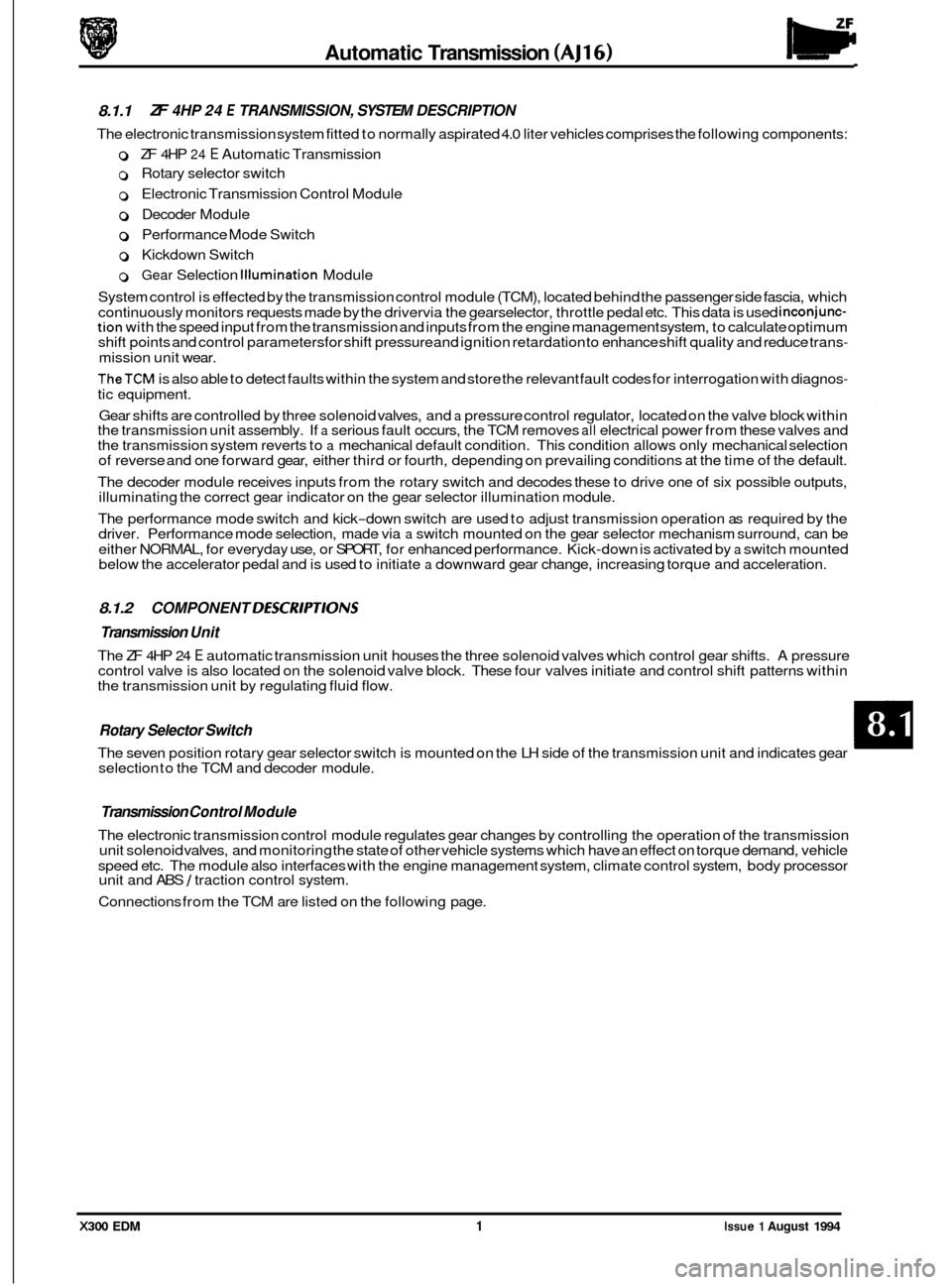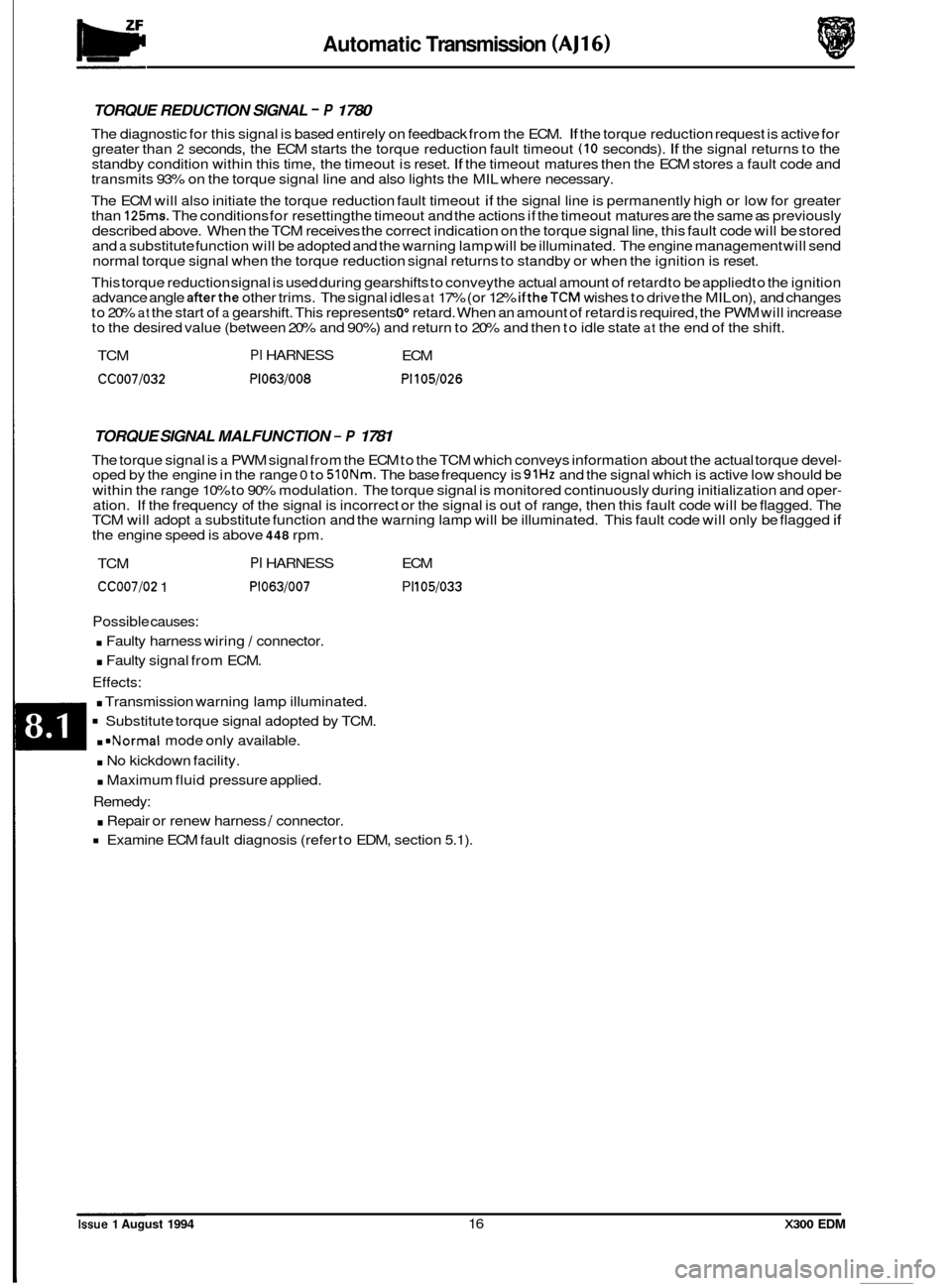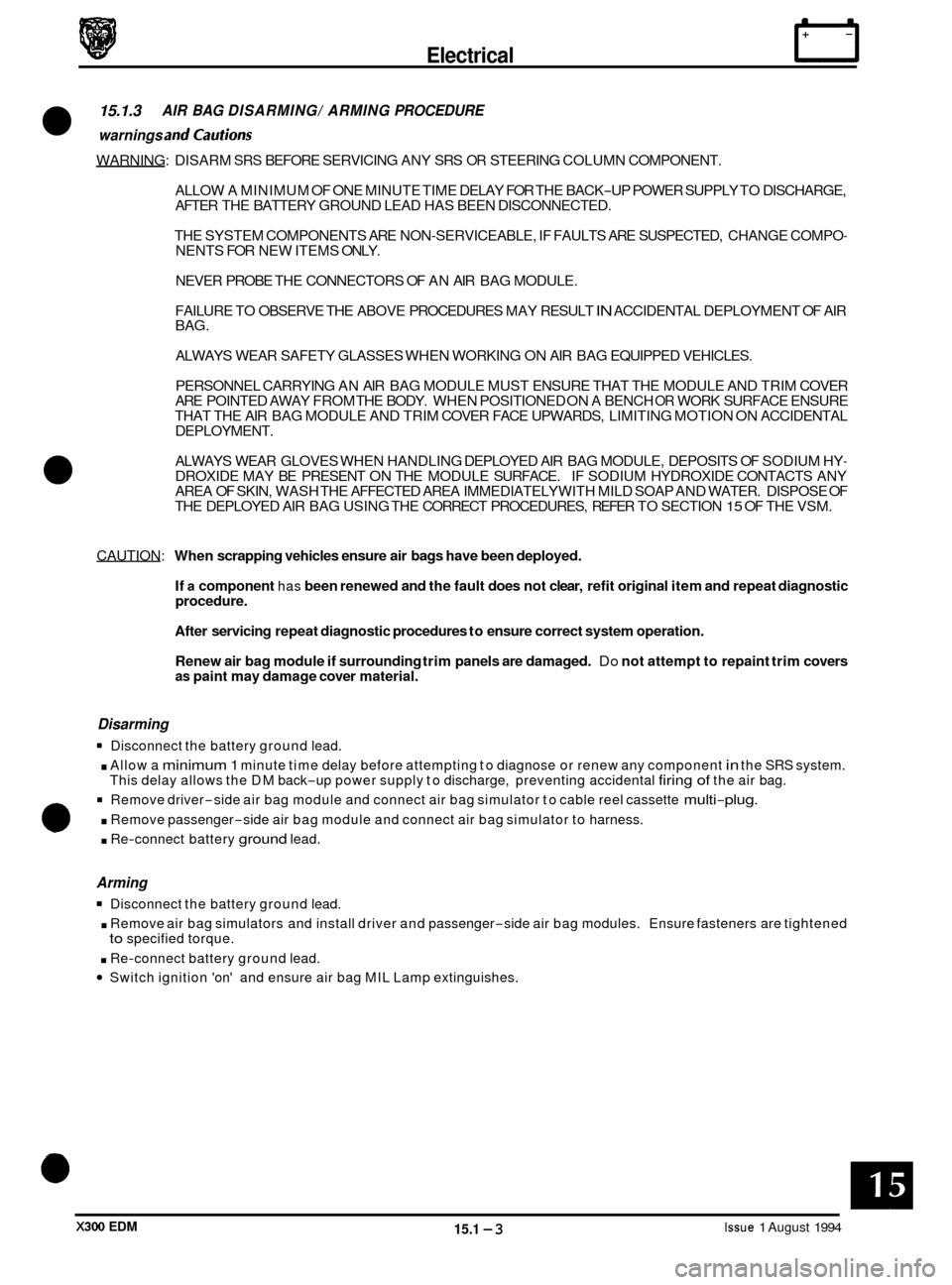1994 JAGUAR XJ6 change time
[x] Cancel search: change timePage 4 of 327

Automatic Transmission (AJ16) w
8.1.1 ZF 4HP 24 E TRANSMISSION, SYSTEM DESCRIPTION
The electronic transmission system fitted to normally aspirated 4.0 liter vehicles comprises the following components:
0 ZF 4HP 24 E Automatic Transmission
0 Rotary selector switch
0 Electronic Transmission Control Module
0 Decoder Module
0 Performance Mode Switch
0 Kickdown Switch
0 Gear Selection Illumination Module
System control is effected by the transmission control module (TCM), located behind the passenger side fascia, which
continuously monitors requests made by the drivervia the gearselector, throttle pedal etc. This data is used
inconiunc- tion with the speed input from the transmission and inputs from the engine management system, to calculate optimum
shift points and control parametersfor shift pressure and ignition retardation to enhance shift quality and reduce trans-
mission unit wear.
TheTCM is also able to detect faults within the system and store the relevant fault codes for interrogation with diagnos-
tic equipment.
Gear shifts are controlled by three solenoid valves, and
a pressure control regulator, located on the valve block within
the transmission unit assembly. If a serious fault occurs, the TCM removes all electrical power from these valves and
the transmission system reverts to a mechanical default condition. This condition allows only mechanical selection
of reverse and one forward gear, either third or fourth, depending on prevailing conditions at the time of the default.
The decoder module receives inputs from the rotary switch and decodes these to drive one of six possible outputs,
illuminating the correct gear indicator on the gear selector illumination module.
The performance mode switch and kick
-down switch are used to adjust transmission operation as required by the
driver. Performance mode selection, made via a switch mounted on the gear selector mechanism surround, can be
either NORMAL, for everyday use, or SPORT, for enhanced performance. Kick
-down is activated by a switch mounted
below the accelerator pedal and is used to initiate a downward gear change, increasing torque and acceleration.
8.1.2 COMPONENT DESCRlPTIONS
Transmission Unit
The ZF 4HP 24 E automatic transmission unit houses the three solenoid valves which control gear shifts. A pressure
control valve is also located on the solenoid valve block. These four valves initiate and control shift patterns within
the transmission unit by regulating fluid flow.
Rotary Selector Switch
The seven position rotary gear selector switch is mounted on the LH side of the transmission unit and indicates gear
selection to the TCM and decoder module.
Transmission Control Module
The electronic transmission control module regulates gear changes by controlling the operation of the transmission
unit solenoid valves, and monitoring the state of other vehicle systems which have an effect on torque demand, vehicle
speed etc. The module also interfaces with the engine management system, climate control system, body processor
unit and ABS
I traction control system.
Connections from the TCM are listed on the following page.
X300 EDM 1 Issue 1 August 1994
Page 19 of 327

Automatic Transmission (AJ16)
TORQUE REDUCTION SIGNAL - P 1780
The diagnostic for this signal is based entirely on feedback from the ECM. If the torque reduction request is active for
greater than 2 seconds, the ECM starts the torque reduction fault timeout (IO seconds). If the signal returns to the
standby condition within this time, the timeout is reset. If the timeout matures then the ECM stores a fault code and
transmits 93% on the torque signal line and also lights the MIL where necessary.
The ECM will also initiate the torque reduction fault timeout
if the signal line is permanently high or low for greater
than 125ms. The conditions for resetting the timeout and the actions if the timeout matures are the same as previously
described above. When the TCM receives the correct indication on the torque signal line, this fault code will be stored
and
a substitute function will be adopted and the warning lamp will be illuminated. The engine management will send
normal torque signal when the torque reduction signal returns to standby or when the ignition is reset.
This torque reduction signal is used during gearshifts to conveythe actual amount of retard to be applied to the ignition
advance angle
afterthe other trims. The signal idles at 17% (or 12% if theTCM wishes to drive the MIL on), and changes
to 20% at the start of a gearshift. This represents 0" retard. When an amount of retard is required, the PWM will increase
to the desired value (between 20% and 90%) and return to 20% and then to idle state at the end of the shift.
TCM
PI HARNESS ECM
CC007/032 P1063/008 P1105/026
TORQUE SIGNAL MALFUNCTION - P 1781
The torque signal is a PWM signal from the ECM to the TCM which conveys information about the actual torque devel- oped by the engine in the range 0 to 510Nm. The base frequency is 91Hz and the signal which is active low should be
within the range 10% to 90% modulation. The torque signal is monitored continuously during initialization and oper
- ation. If the frequency of the signal is incorrect or the signal is out of range, then this fault code will be flagged. The
TCM will adopt a substitute function and the warning lamp will be illuminated. This fault code will only be flagged if the engine speed is above 448 rpm.
TCM
PI HARNESS ECM
CC007/02 1 P1063/007 PI 105/033
Possible causes:
. Faulty harness wiring I connector.
. Faulty signal from ECM.
Effects:
. Transmission warning lamp illuminated.
Substitute torque signal adopted by TCM.
. =Normal mode only available.
. No kickdown facility.
. Maximum fluid pressure applied.
Remedy:
. Repair or renew harness / connector.
Examine ECM fault diagnosis (refer to EDM, section 5.1).
Issue 1 August 1994 16 X300 EDM
Page 32 of 327

Automatic Transmission (V12) Powertrain
8.2.1 POWERTRAIN
41-80-E TRANSMISSION, SYSTEM DESCRIPTION
The electronic transmission system fitted to 6.0 liter and 4.0 liter super-charged vehicles comprises the following com- ponents:
0 Hydra-matic 4L-80-E Automatic Transmission
0 Electronic Transmission Control Module
0 Performance Mode Switch
0 Kickdown Switch
0 Gear Selection Module (illuminated)
System control is effected by the transmission control module
(TCM), located behind the passenger side fascia, which continuously monitors requests made bythe driver via the gearselector, throttle pedal etc. This data is used inconjunc- tion with the speed input from the transmission and inputs from the engine management system, to calculate optimum
shift points and control parametersfor shift pressure and ignition retardation to enhance shift quality and reduce trans- mission unit wear.
TheTCM is also able to detect faults within the system and store the relevant fault codes for interrogation with diagnos- tic equipment.
Gear shifts are controlled
by three solenoid valves, and a pressure control regulator, located on the valve block within
the transmission unit assembly. If a serious fault occurs, the TCM removes all electrical power from these valves and
the transmission system reverts to a mechanical default condition. This condition allows only mechanical selection
of reverse and one forward gear, either
third or fourth, depending on prevailing conditions at the time of the default.
The performance mode switch and kick
-down switch are used to adjust transmission operation as required by the
driver. Performance mode selection, made via a switch mounted on the selector switch surround, can be either NOR- MAL, for everyday use, or SPORT, for enhanced performance. Kick-down is activated by a switch mounted below the
accelerator pedal and is used to initiate a downward gear change, increasing torque and acceleration.
8.2.2 COMPONENT DESCRIPTIONS
Transmission Unit
The powertrain 4L-80-E transmission unit houses the two solenoid valves which control gear shifts. A pressure control
valve is also located on the solenoid valve block. These three valves initiate and control shift patterns within the trans- mission unit by regulating fluid flow.
Performance Mode Switch
The two position performance mode switch allows selection of 'sport' or 'normal' mode as required by the driver. The
switch input to TCM causes a gear shift pattern change so that gear shifts take place at higher engine revs, enhancing
performance, when in 'sport' mode. For everyday use, 'normal' mode utilises a shift pattern for optimum driver com- fort.
Kickdown Switch
The 'kick-down' facility is activated when full downward travel of the accelerator pedal occurs.
Activation of the switch provides a signal to TCM indicating that greater acceleration, and hence downward gear shifts
are required. Switch height is adjustable
so that kick-down can be achieved at a pre-determined throttle opening.
Gear Selection Illumination Module
This module is located above the gear selector mechanism and its sole purpose is to display the selected gear (in red)
on receipt of a signal from the decoder module.
X300 EDM 1 Issue 1 August 1994
Page 109 of 327

Electrical rl
15.1.3 AIR BAG DISARMING/ ARMING PROCEDURE
warnings and cautions
WARNING: DISARM SRS BEFORE SERVICING ANY SRS OR STEERING COLUMN COMPONENT.
ALLOW A MINIMUM OF ONE MINUTE TIME DELAY FOR THE BACK
-UP POWER SUPPLY TO DISCHARGE,
AFTER THE BATTERY GROUND LEAD HAS BEEN DISCONNECTED.
THE SYSTEM COMPONENTS ARE NON
-SERVICEABLE, IF FAULTS ARE SUSPECTED, CHANGE COMPO- NENTS FOR NEW ITEMS ONLY.
NEVER PROBE THE CONNECTORS OF AN AIR BAG MODULE.
FAILURE TO OBSERVE THE ABOVE PROCEDURES MAY RESULT
IN ACCIDENTAL DEPLOYMENT OF AIR
BAG.
ALWAYS WEAR SAFETY GLASSES WHEN WORKING ON AIR BAG EQUIPPED VEHICLES.
PERSONNEL CARRYING AN AIR BAG MODULE MUST ENSURE THAT THE MODULE AND TRIM COVER
ARE POINTED AWAY FROM THE BODY. WHEN POSITIONED ON A BENCH
OR WORK SURFACE ENSURE
THAT THE AIR BAG MODULE AND TRIM COVER FACE UPWARDS, LIMITING MOTION ON ACCIDENTAL
DEPLOYMENT.
ALWAYS WEAR GLOVES WHEN HANDLING DEPLOYED AIR BAG MODULE, DEPOSITS OF SODIUM HY
- DROXIDE MAY BE PRESENT ON THE MODULE SURFACE. IF SODIUM HYDROXIDE CONTACTS ANY
AREA OF SKIN, WASH THE AFFECTED AREA IMMEDIATELY WITH MILD SOAP AND WATER. DISPOSE OF
THE DEPLOYED AIR BAG USING THE CORRECT PROCEDURES, REFER TO SECTION
15 OF THE VSM.
CAUTION:
When scrapping vehicles ensure air bags have been deployed.
If
a component has been renewed and the fault does not clear, refit original item and repeat diagnostic
procedure.
After servicing repeat diagnostic procedures to ensure correct system operation.
Renew air bag module if surrounding trim panels are damaged.
Do not attempt to repaint trim covers as paint may damage cover material.
Disarming
. Allow a minimum 1 minute time delay before attempting to diagnose or renew any component in the SRS system.
Remove driver-side air bag module and connect air bag simulator to cable reel cassette multi-plug.
. Remove passenger-side air bag module and connect air bag simulator to harness.
. Re-connect battery ground lead.
Disconnect
the battery ground lead.
This delay allows the DM back
-up power supply to discharge, preventing accidental firing of the air bag.
0
Arming
Disconnect the battery ground lead.
. Remove air bag simulators and install driver and passenger-side air bag modules. Ensure fasteners are tightened
. Re-connect battery ground lead.
Switch ignition 'on' and ensure air bag MIL Lamp extinguishes.
to specified torque.
X300 EDM 15.1 -3 Issue 1 August 1994
Page 209 of 327

rl E I ect r ical
15.4.6 NON-MEMORY AND MANUAL APPLICATIONS
15.4.6.1
Non-Memory
Seats, column and mirrors may be supplied without memoryfacilities on certain vehicles. In this case, adjustment of
each application is still controlled in the same way but the memory facility is disabled and the memory switch pack
not fitted.
15.4.6.2 Manual Seats
Manual seats are adjustable vertically and horizontally, vertical adjustment being motorized but horizontal adjustment
manually effected. The seats have heated cushions and squab, but are not operated by an electronic control module.
Control is effected using three relays, two for vertical adjustment and one for heating.
Vertical adjustment is requested
by operation of a switch located on the left-hand side of the seat front which completes
the electrical supply to either the raise or lower relay as required. When either relay is energized a change of contact
state connects one side of the motor to
+12V and the other side to ground. Reverse operation reverses supply and
ground connection.
Heating is still controlled by a timed output from the BPU. Operation of a switch located on the
center console indicates
to BPU that heating is required. Battery voltage is then applied to the heater relay for 11 minutes. The relay contact
completes the heater circuit, providing seat heating (and illuminating the switch surround) until the timer expires, or
optimum seat temperature is achieved. Operation of the heater switch before 'time-out' is achieved cancels the heat- ing request. Operation of the heater switch after 'time-out' has been achieved re-starts the heating cycle.
15.4.6.3 Manual Column
Manual column adjustment in the two planes is achieved by purely mechanical means, release catches allowing col-
umn movement within a fixed locking mechanism.